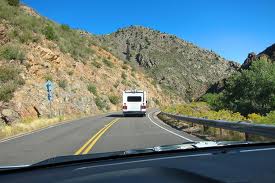RV Mountain Driving
Jessica
If you’ve ever driven your RV in the mountains, then you know it can present some unique challenges. Many mountain roads have steep grades and the weight of an RV makes going up and down steeper hills more difficult in an RV than a car.
This blog post provides you with a few helpful RV mountain driving tips to help you the next time you are driving on some of these steep roads.

Before Your Trip
First of all, you should check the condition of your rig before leaving. Make sure your brakes are working well and that you have adequate brake fluid. Also, check your transmission fluid. Check your tires and make sure that they have good tread for grip and that they are properly inflated.
It is also a good idea to find a hilly spot near your home to practice, especially if you’ve never driven your RV in the mountains before. It helps to know what to expect and how your particular RV handles under similar road conditions.
General Driving Tips
When driving on mountain roads the most important thing is to drive at a safe speed. You’ll want to drive slower in than the rest of the cars because of your vehicle’s weight, not to mention being able to view the sights. If cars start to pile up behind you, pull over at one of the designated spots to let them pass.
Many rookie RV drivers tend to stick towards the line in the road, avoiding the edge. However, you should always try to stick to the center of your lane because other drivers may be doing the same thing. Also, remember to watch your temperature gauge and if it gets too hot, pull over for a bit and let it cool down.

Driving Uphill
When driving up a hill, you want to keep your engine in its “power band.” This is a span of RPMs where your engine produces the most horsepower, which is important for handling the extra loads involved in climbing hills. The power band varies among different RVs, but usually is somewhere between 2000 and 4000 RPMs.
The trick to climbing steep hills effectively is to shift down and get your engine in its power band before you reach the incline of the hill. Be careful to keep it in the power band as you climb, otherwise you run the risk of overheating your engine.
Driving Downhill
Going downhill in your RV can be more difficult than going up. You don’t want to just use your brakes because they can overheat which reduces their effectiveness and can cause them to fail completely.
To save your brakes, you can use your engine and transmission to help slow you down. As you approach the crest of the hill, try putting your RV in second gear while maintaining your speed at 40 mph. If the RV isn’t staying at a manageable speed, try going down to first gear and bringing your speed down to 20 mph to be safe. Remember, it’s always safer to be in too low of a gear than too high of a gear.
If you need to use your brakes to help slow you down, brake hard for short durations. It is better for your brakes to brake hard in shorter bursts than to brake lighter but constantly.
Driving an RV in the mountains can be difficult, but following these tips and getting some experience under your belt can help make it safer and more enjoyable. Happy driving!
